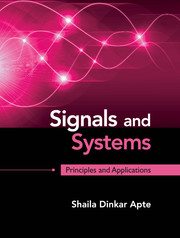Book contents
- Frontmatter
- Dedication
- Contents
- Preface
- 1 Introduction to Signals
- 2 Signals and Operations on Signals
- 3 CT and DT Systems
- 4 Time Domain Response of CT and DT LTI Systems
- 5 Fourier Series Representation of Periodic Signals
- 6 Fourier Transform Representation of Aperiodic Signals
- 7 Laplace Transform
- 8 Z Transform
- 9 Random Signals and Processes
- Index
7 - Laplace Transform
Published online by Cambridge University Press: 05 May 2016
- Frontmatter
- Dedication
- Contents
- Preface
- 1 Introduction to Signals
- 2 Signals and Operations on Signals
- 3 CT and DT Systems
- 4 Time Domain Response of CT and DT LTI Systems
- 5 Fourier Series Representation of Periodic Signals
- 6 Fourier Transform Representation of Aperiodic Signals
- 7 Laplace Transform
- 8 Z Transform
- 9 Random Signals and Processes
- Index
Summary
We will discuss the unilateral and bilateral Laplace Transform (LT) and its significance in analyzing the systems. The significance of complex frequency will be discussed. The relation between LT and FT will be explained. Different examples based on calculation of LT and inverse LT will be solved. LT of some standard signals will be evaluated. LT is very useful for analyzing the stability of the system. Stability of the system in Laplace domain will be explained.
Definition of Laplace Transform
Laplace transform was first proposed by Laplace (year 1980). This is the operator that transforms the signal in time domain in to a signal in a complex frequency domain called as ‘S’ domain. The complex frequency domain will be denoted by S and the complex frequency variable will be denoted by ‘s’. Let us understand the significance of Laplace transform. The reader must be familiar with complex numbers. The complex frequency S can be likewise defined as s = σ + jω, where σ is the real part of s and jω is the imaginary part of s. The complex numbers are defined by mathematicians and are the mathematical abstractions useful for the analysis of signals and systems. It simplifies the mathematics. Similarly, the complex frequency plane is also the mathematical abstraction useful for the simplification of mathematics. Laplace transform does not have any physical significance. We can just say that ω stands for the real frequency and Laplace transform transforms the signal from time domain to some kind of frequency domain.
Physical significance of Laplace transform Laplace transform has no physical significance except that it transforms the time domain signal to a complex frequency domain. It is useful to simply the mathematical computations and it can be used for the easy analysis of signals and systems. The stability of the system is directly revealed when the transfer function of the system is known in Laplace domain. LT is used for solving differential equations.
- Type
- Chapter
- Information
- Signals and SystemsPrinciples and Applications, pp. 513 - 617Publisher: Cambridge University PressPrint publication year: 2016



